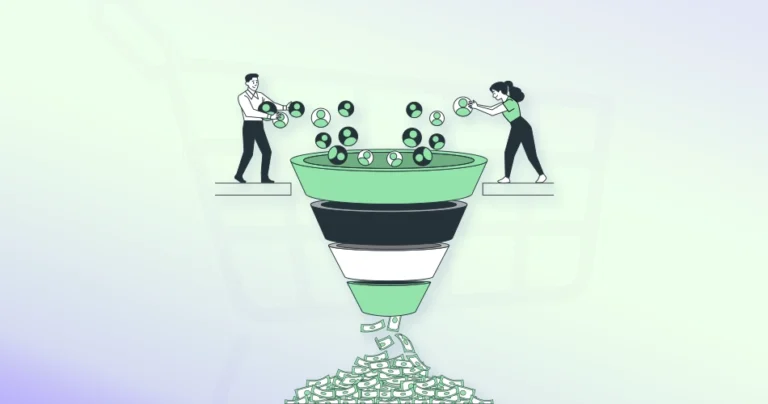Imagine this: a potential customer stumbles upon your online store, but gets lost in a maze of products and confusing navigation. That’s where a well-defined eCommerce sales funnel comes in. It’s the key to turning website visitors into customers.
The eCommerce experts implement a sales funnel to nurture interest, build trust, and ultimately lead to a purchase. It helps optimize the customer journey and improve the overall experience for better sales.
Let’s see the key aspects of the eCommerce sales funnel, its benefits, and implementation strategies.
What is a Sales Funnel?
A sales funnel is a visual representation of the journey a potential customer takes on your website. That goes from initial awareness of your brand or product to the final purchase decision.
Imagine a funnel with a wide opening at the top and a narrow spout at the bottom. After going through your sales and marketing messages, the interested individuals go down the funnel. And finally, a small portion of them go on to buy the products.
Here are the typical stages of a sales funnel:
- Top of Funnel (TOFU): This is where you generate awareness and capture interest. You might use social media posts, blog content, or free trials to attract potential customers.
- Middle of Funnel (MOFU): Here, you nurture leads by providing valuable content that addresses their pain points and showcases your expertise. This could include product demos, case studies, or email marketing campaigns.
- Bottom of Funnel (BOFU): This stage focuses on driving conversions. You might offer special promotions, highlight product benefits, or provide clear calls to action to encourage purchases.
This basic funnel will guide your visitors to take the action which you deem as successful for your business and website. But stages do the eCommerce development services target with their sales funnels? Let’s see.
Key Stages of eCommerce Sales Funnel
Typically, the eCommerce sales funnel is split into 5 key stages: Awareness, Interest, Consideration, Intent, and Purchase.
Awareness
This broad, first stage of funnel is where you cast a wide net to capture the attention of a large audience. They might not be aware of your brand or the specific problem your product solves. So your goal here is to generate brand awareness, spark initial interest, and introduce your brand as a trusted resource.
Strategies
- Implement content marketing with valuable blogs, videos, and infographics to address the needs or interests of your target audience.
- Implement social media marketing to reach a wide audience and build brand awareness.
- Optimize your eCommerce website with SEO to rank higher in search engine results.
- Implement other strategies like PPC advertising, influencer marketing, and more.
Interest
At this stage, you’ve captured some attention, and now you want to turn that spark into a desire for your product. Here, you nurture leads with valuable content that addresses their specific needs and showcases product’s problem solving capabilities. Go beyond generic features and benefits – delve into the emotions and pain points of your target audience.
Strategies
- Implement email marketing to nurture interest with informative and engaging newsletters, special offers, and updates.
- Interact with followers, respond to comments, and create engaging content to keep them interested.
- Use personalized content recommendations based on user behavior and preferences.
- Offer free resources (e.g., eBooks, webinars, discounts) in exchange for contact information.
Consideration
Now, potential customers are aware of your brand and have some interest in your product. They’re actively considering their options and comparing different products or services to find the best solution for their needs. Here, your goal is to establish yourself as the best choice. Highlight your product’s unique selling points (USPs), address common objections, and build trust.
Strategies
- Use social proof to showcase positive customer reviews and testimonials to build trust and credibility.
- Provide comprehensive product descriptions, high-quality images, and videos.
- Create comparison guides that highlight the benefits and unique features of your products versus competitors.
- Share real-life examples of how your products have helped other customers.
Intent
In the intent stage, potential customers show clear signs of wanting to make a purchase. They may add items to their cart, sign up for a free trial, or request a demo. The focus here is to convert their intent into action.
Strategies
- Implement retargeting strategies to remind potential customers about the products in their cart.
- Send follow-up emails to customers who have abandoned their carts. Offer incentives to complete the purchase.
- Create a sense of urgency with limited-time discounts or promotions.
- Provide immediate assistance through live chat or customer support
Purchase
The sales funnel doesn’t end with the purchase! A loyal customer base is essential for repeat business and positive word-of-mouth promotion. Here, you focus on building long-term relationships with your customers and encouraging repeat purchases.
Strategies
- Simplify the checkout process with minimal steps and multiple payment options.
- Ensure that all transactions are secure and that you offer trusted payment gateways.
- Focus on eCommerce fulfillment. Send order confirmation emails and follow-up emails with shipping and delivery info.
- Provide excellent customer service for the best satisfaction.
Make sure you implement this eCommerce sales funnel and the key strategies when starting and running an eCommerce business. If you need to help with any part of the funnel implementation, consult with our eCommerce website development company.
How to Implement the eCommerce Sales Funnel?
Implementing an effective eCommerce sales funnel requires a strategic approach that considers your target audience, website optimization, and data-driven analysis. Here’s how this process goes:
Step 1: Define Your Target Audience
Before diving into funnel creation, clearly define your ideal customer profile. Who are you trying to reach? What are their demographics, interests, and pain points? Understanding your target audience allows you to tailor your content and messaging throughout the funnel for maximum impact.
Step 2: Map the Customer Journey
Visualize the steps a potential customer takes on your website, from initial awareness to final purchase. This customer journey map will guide your funnel structure and identify key touchpoints where you can influence their decision-making.
Step 3: Craft Compelling Content
Develop high-quality content marketing strategy for each stage of the funnel. It will help nurture leads and address their specific needs. This could include blog posts, infographics, videos, ebooks, or social media content. Focus on providing valuable information, showcasing your expertise, and establishing trust with your audience.
Step 4: Optimize Your Website
Ensure your website is user-friendly, visually appealing, and optimized for conversions. This includes clear navigation, high-quality product pages, and a seamless checkout process. Make sure your website is mobile-friendly, as a significant portion of online shopping happens on mobile devices.
Step 5: Leverage Marketing Channels
Implement the top eCommerce marketing strategies to drive traffic to your eStore at the top of the funnel stage. Explore social media marketing, email marketing, search engine optimization (SEO), and pay-per-click (PPC) advertising to reach your target audience and generate brand awareness.
Step 6: Integrate Analytics & Tracking
Implement eCommerce analytics to track user behavior and measure the effectiveness of your funnel at each stage. Tools like Google Analytics can reveal valuable insights into conversion rates, bounce rates, and user engagement. This data will help you identify areas for improvement and optimize your funnel for better results.
Step 7: A/B Test & Refine
Don’t be afraid to experiment! A/B testing allows you to compare different versions of your website elements, landing pages, or CTAs to see what resonates best with your audience. Use data-driven insights to continuously refine your funnel and maximize conversions.
Step 8: Build Relationships
The sales funnel isn’t just about driving conversions – it’s about building long-term relationships with your customers. Provide excellent customer service, address concerns promptly, and offer valuable resources to build trust and loyalty (with eCommerce personalization and customer retention strategies).
Following this eCommerce sales funnel process will help nurture leads, drive sales, and achieve long-term success effectively.
If you need help with implementing it for your eStore, opt for our eCommerce consulting services. We will give you the best recommendations on running a successful eCommerce sales funnel in your store.
Conclusion
A well-defined eCommerce sales funnel is the key to transforming website visitors into loyal, repeat customers. It involves key stages like Awareness, Interest, Consideration, Intent, and Purchase.
Make sure to define your target audience and map their potential journey. Then it’s time to craft compelling content, optimize the store, and implement the marketing strategies. Finally, monitor the sales and experience and optimize the funnel accordingly.
If you need help with the implementation of the eCommerce sales funnel, consult with our experts today!
FAQs on eCommerce Sales Funnel
Q1. How long does it take to see results from a sales funnel?
The time frame depends on various factors like your industry, target audience size, and marketing efforts. However, with a well-designed and optimized funnel, you can start seeing results within a few weeks or months. Be patient, analyze data, and continuously refine your approach.
Q2. Do I need a large budget to implement a sales funnel?
No, you don’t necessarily need a huge budget. There are many free or low-cost strategies like SEO, content marketing, and social media marketing that can be highly effective. However, paid advertising can accelerate results if implemented strategically.
Q3. How can I measure the success of my sales funnel?
Use website analytics tools to track key metrics like conversion rates, bounce rates, average order value, and customer acquisition costs. Analyze data to identify strengths and weaknesses, then refine your funnel to optimize performance.





